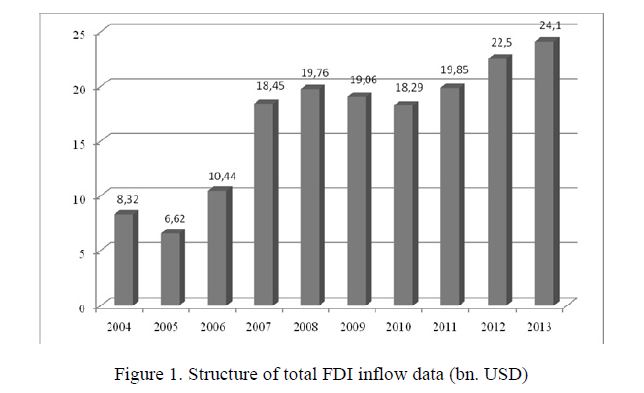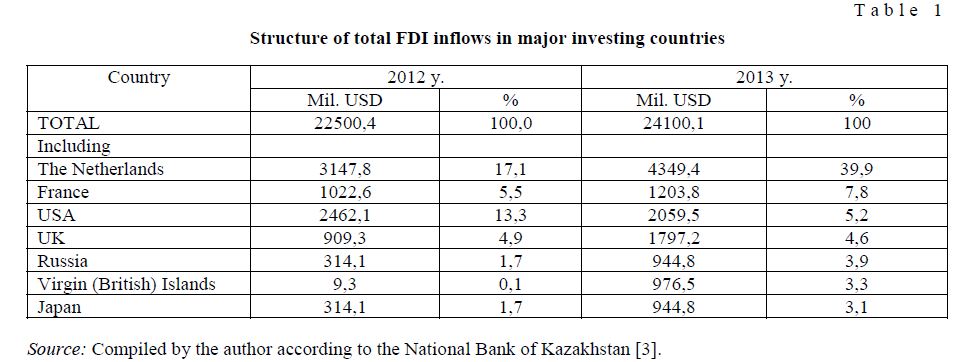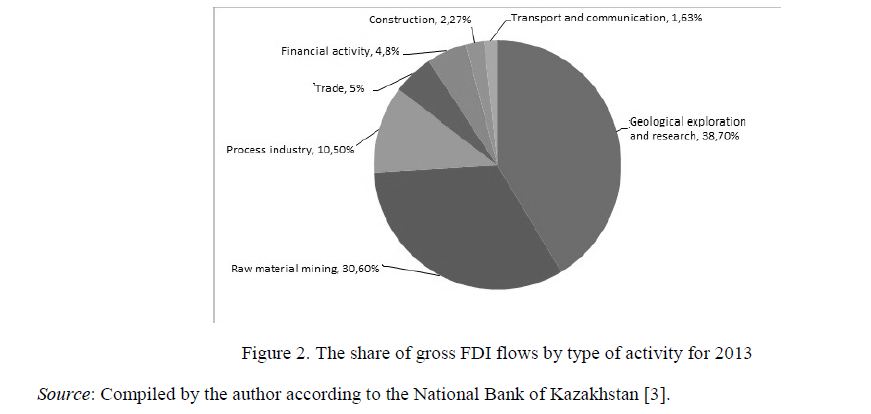This article analyses the current state of investment climate in Kazakhstan. In particular, attraction of direct foreign investments in the sectors of Kazakh economy is studied. Main directions of foreign investment inflow attraction and stimulation state regulation and financial control of their use have been determined.
Within the strategy «Kazakhstan–2050», The President of Kazakhstan, N.A.Nazarbayev has defined a new course of economic policy — a comprehensive economic pragmatism based on the principles of profitability, return from investment and competitiveness [1]. According to the new course, in Kazakhstan, a favorable investment climate should be created, in order to increase economic potential. It is an effective state investment policy that affects the progress of economic development of the state. This progress is primarily in the positive dynamics of macroeconomic indicators: GDP growth, living standards of the state's citizens rising. According to statistics, in the Republic of Kazakhstan people's lives have improved. Thus, in dynamics for the last 8 years the GDP grew by 62,6 %, the proportion of people having less than a living wage significantly reduced, to almost 1 % decreased the depth of poverty in Kazakhstan. That is, these are the problems that today President of Kazakhstan pays special attention to, their positive trend is largely determined by investment activities.
One of the main challenges that modern Kazakhstan faces is to ensure sustainable economic development in complex environmental, social, political and economic conditions of the world economy globalization and the crisis. In this connection, it is necessary to prioritize the use of investment development projects aimed at creating an advanced economy by using qualitatively new economic levers ensuring stability and balanced development of the state [1]. Strategic objectives of the country's economy, the need to integrate into the global economy have raised the need to develop a model that is based on the active role of the state in attracting foreign investment.
Kazakhstan possesses rich mineral resources, vast agricultural lands, and skilled personnel. The country has a significant industrial potential. But to further effective use of natural and labor resources a large capital is required, as well as its profitability. Tasks that were defined in the «Strategy 2030» on attracting foreign investment in the economy were carried out in the shortest possible time. World Bank has included Kazakhstan into the list of 20 countries that attract the largest amount of investments.
Analyzing the Republic of Kazakhstan investment policy, it should be noted that the main purpose of the state is to achieve a favorable investment climate in the country and further encourage foreign direct investment in the economy. Today Kazakhstan has a leading position in terms of volume of attracted foreign investments per capita among the CIS countries. The amount of foreign direct investment (hereinafter — FDI) per capita in 2012 was $1,350 per person, which is more than 2,5 times the 2005 figure. For comparison, the volume of investment per capita in the Republic of Belarus amounted to $1,090 per person. In the Russian Federation — $130 dollars per person [2; 24].
Indicating the favorable investment climate and image of our country is the volume of attracted investments in Kazakhstan's economy. According to the National Bank of the Republic of Kazakhstan, for the period from 2005 to 2013 there were attracted more than $196 billion foreign direct investments in the domestic economy (Figure 1). Yielding to the gross volume of foreign direct investments only to Russia, Kazakhstan is a leader in the CIS in terms of foreign direct investments per capita and their share in the country's GDP [3].

Figure 1. Structure of total FDI inflow data (bn. USD)
As seen on a diagram, in 2007–2008, that is in the midst of the global financial crisis, when global FDI flows decreased almost two times, Kazakhstan, on the contrary, sharply boosted its income. Moreover, in 2008, its volume reached $19,76 billion which is $131 million more than the previous record registered in 2007.
The gross inflows of foreign direct investments in the countries in the reporting period was dominated by the Netherlands (39,9 % of total FDI revenues), followed with a large margin by France (7,8 %), China (5,9 %), USA (5,2 %), UK (4,6 %), Russia (3,9 %), Virgin (British) Islands (3,3 %) and Japan (3,1 %) (Table 1). Which is while the overall list of countries that have invested in Kazakhstan's economy includes more than 120 countries [3].
Structure of total FDI inflows in major investing countries
T a b l e 1

Source: Compiled by the author according to the National Bank of Kazakhstan [3].
Meanwhile, despite the positive dynamics of investments, their significant diversification has not happened. Thus, the analysis of the sectoral structure of 100 largest Kazakhstan investing companies (in terms of sales) shows that most of them is still operating in oil and gas sector of the country. The activity of investors in energy and mineral complex is much higher than in the real sector of Kazakh economy.
In particular, out of $196,633 billion foreign direct investments attracted in the years 2005–2013, $56,7792 billion (38,7 %) was directed to conduct geological exploration and research, and $44,8839 billion (30,6 %) — in production of raw material resources. In the manufacturing sector, foreign corporations have invested only $15,4118 billion (10,5 %). Followed by trade — $7,3227 billion (5 %), financial activities — $7,155 billion (4,88 %), construction — $3,3355 billion (2,27 %), as well as transport and communications — $2,3912 billion (1,63 %). The share of other types of economic activity had a little more than 1 % of all foreign direct investments (Figure 2) [3].

Figure 2. The share of gross FDI flows by type of activity for 2013
Source: Compiled by the author according to the National Bank of Kazakhstan [3].
Due to extremely uneven distribution of investments, sector imbalances are exacerbated by imbalances at the level of economic development of regions. Thus, according to the Statistics Agency, the share of the cities of Almaty and Astana, as well as Western Kazakhstan, Atyrau, Aktobe, Mangistau and Kyzylorda regions (where mineral sector companies are focused) accounts for about 60 % of all investments of the country. In these regions more than 80 % of all enterprises with participation of foreign investors or affiliates of TNCs work [4; 29].
Thus, favorable conditions for investment in non-oil sector (including the provision of tax preferences, guarantees against changes in the law), provided by the legislation of Kazakhstan, has not contributed to the intensive growth of investment in industries producing goods with high added value. This is understandable: the implementation of high-tech projects, usually associated with large investment is a higher risk than the extraction of raw materials. Accordingly, in order to attract investors in such projects, it is necessary to create the most comfortable conditions and reduce risks. And on a background of tightening of global competition for foreign direct investment, it is not a simple task.
Analysis of foreign investor survey shows that among the factors restraining them from participating in non-oil projects in Kazakhstan include:
- the lack of consistency in implementation of the state investment policy;
- the instability of the legislation and the lack of mechanisms to ensure compliance with laws and contractual relationships;
- largely uncompetitive conditions to attract investment (including customs and currency regimes);
- the lack of development of infrastructure and services to ensure the attraction of investments (including financial, banking, information and analysis, consulting, transport, );
- the instability of the system of government in attracting investment (constant reorganization of central agencies involved in foreign capital, a «spread» of rights, powers and responsibilities among numerous agencies, as well as intricacies of their functions);
- current visa regime [5; 31].
In this regard, in 2010 under the State program for acceleration of industrial and innovative development for 2003–2015 the government of Kazakhstan has begun to reformat the system of interaction with foreign investors. Thus, in October 2010, adopted was the Program of attracting investment, developing special economic zones and export promoting for 2010–2014. In accordance with this Program, work was initiated with major foreign companies of key investor countries from 200 investment initiatives. In two years, there were organized and hosted more than 20 international business forums with the participation of transnational corporations. As a result, if in 2010, Kazakhstan was visited by around 5,000 foreign investors, in 2011 there were already more than 10 thousand.
In addition, in 2010 launched was the national investment website www.invest.gov.kz, where in 12 languages is available all the necessary information about the conditions of business in the country (up to the cost of utilities in each region) [6].
In order to improve the investment legislation in 2011 adopted was a new law on special economic zones, as well as the law on state support of industrial innovation, a significant expansion of the current benefits package and simplification of licensing procedures for participants of the FEZ. However, in 2011 the Ministry of Industry and New Technologies has proposed to return to the Law «On investments» rule on the stability of legislation similar to that which operated from 1994 to 2004, but now only for the manufacturing sector.
According to research by MINT, currently the investment capacity of Kazakhstan has potential sufficient for growth. Only by improving the competitiveness of the economy and more efficient use of existing strengths annual inflow of foreign direct investment can be increased by $10 billion. In order to implement this potential, the Ministry has formed a National Plan on attracting investment, developing FEZ and export promoting, which was approved by the Government of the Republic of Kazakhstan on December 23, 2011.
The plan, first of all, provides for a more systematic work with foreign investors. To this end, identified were priority sectors of industry and revealed 20 priority investing countries by size of their investment in the these industries. By analyzing the strategies of leading companies in these countries and the prospects of a particular sector of the national economy, for each of them have been identified approximate time periods and the number of transnational corporations involved. Thus, by 2014 a work with a total of 78 international corporations was conducted, and in 2015–2020 the number will rise to 81 multinational corporations.
In this case, each major potential investor will be negotiated individually. This point approach involves performing a road-show in priority countries, as well as the development and implementation of «road maps» for interaction with target investors. This includes assistance in the passage of procedures associated with the opening and running business in Kazakhstan, the organization of meetings with key political leaders and top managers of leading domestic companies; consulting services both at the stage of development of the investment project, and at the stage of its implementation, as well as post-investment support.
An important factor in working with investors will be their support in regions of Kazakhstan. To do this, in each area investor service centers will be set up, that provide prompt and proper response to the matters of foreign investors in the field and, per se, will serve as regional offices of Agency for Export and Investment «KAZNEX INVEST».
Moreover, now the creation of coordination councils on the investment climate at akimats of regions is being considered, as well as the cities of Astana and Almaty. Their main task will be to assist investors in solving problems, including those related to interaction with government agencies.
In the coming years, the role of state in the process of changing the structure of foreign direct investments will be crucial, and therefore new instruments implemented by the Government as part of attracting «non-primary» investors are inherently quite correct and timely. Work in the right direction has already begun, and more and more frequently travels of our official delegations to foreign countries come to an end by signing new agreements and memoranda in the manufacturing sector. Small wonder that in the latest ranking of Change Readiness Index 2012, prepared jointly by KPMG and Analytical Center of the Institute for International Development, Kazakhstan took 5th place out of 60 states, second only to Chile, Tunisia, Jordan and Taiwan. In this ranking, which assesses the ability of emerging economies to adapt to the rapidly changing global economy, we are significantly ahead of countries such as China, Malaysia, India, Brazil, Turkey and South Africa. With regard to our neighbors in the CIS, Ukraine ranked 37th, while Russia is only 51 th place [7; 15].
One of important trends that must be considered in Kazakhstan in foreign direct investment field, is the fact that over the past two years, developing countries have further increased their weight, both as recipients of foreign direct investments and foreign investors. Since the center of international production, and more recently, international consumption, shifts to the state transition, global players are increasingly investing their money in projects aimed at the development of markets in these countries. In particular, in 2010, emerging markets for the first time have mastered more than half of global foreign direct investment flows, and six transition countries themselves entered the twenty largest investors. The dynamics of transnational corporations from countries with emerging economies contrast with the background of low investment activity of corporations from developed countries whose foreign investments now still account for about half of the peak of 2007.
Meanwhile, global economic cooperation today is no longer being developed exclusively by foreign direct investments and trade. In recent years, the role of an intermediary has increased — ways to organize international production not connected with capital (WNC). These include contract manufacturers and agriculture, services outsourcing, franchising, licensing, management contracts and other types of contractual relationships through which transnational corporations coordinate activities within their global production and sale chains (GPSC). WNC allows them instead of creating a production branch (i.e. foreign direct investment) in the host country to transfer production functions contract manufacturers or allow a local company to manufacture products under license. Thus for the investors themselves WNC projects are characterized by relatively low initial capital costs and reduced risk. In turn, the host countries are able to integrate into GPSCs. As the UNCTAD data shows, in 2010 alone, the volume of sales under this facility exceeded $2 trillion, mostly in developing countries [8; 483].
Based on the foregoing, we can say that Kazakhstan should look closely at the benefits provided under the WNC relations with foreign investors. According to the recommendations of UNCTAD experts, in order to successfully exploit the potential of this mechanism, the public authorities responsible for the development of investment policy, must first answer the following key questions. First, how to integrate policy towards WNC in the overall context of national development strategies. Second, how to support the development of the productive capacity of domestic companies that could qualify for participation in global production and sale chains. And third, how to develop tools to promote and stimulate WNC.
Mineral resource complex is the basis of socio-economic development of Kazakhstan and remains one of the most attractive areas for investment. Total investments in the subsoil use of different types of minerals in the last 12 years has exceeded $200 billion. However, the intensive exploitation of existing fields require mining companies to strengthen the role of the state in advancing geological study.
Investment activity of subsoil users positively impacts on socio-economic indicators of Kazakhstan (Table 2) [9].
The structure of tax payments and payments of subsoil users in 2001–2012 yy., Bn. KZT
T a b l e 2

Thus, for the past 12 years they have provided $2,3 billion on the social sector and local infrastructure (including $317,5 million in 2012), $905,5 million on training specialists, $308,1 million on the purchase of technology. During this time the number of people employed in the CMC increased from 175 thousand people in 2001 to 181 thousand in 2012.
In 2000–2012 years mining companies paid to the budget of Kazakhstan in the form of taxes and charges a total of 13 844,7 billion tenge. And only last year this figure was 3,6536 billion tenge, including 1 172,2 billion (or 32 % of total amount of taxes and payments) accounted for MRMT, 908,6 billion tenge (25 %) — corporate income tax, 39,6 billion tenge (1 %) — social security tax, 18 billion (less than 1 %) — VAT, 3,3 billion — bonuses, 1 511,9 billion tenge — to other taxes and fees [9].
Thus, policy measures on attracting investments in the economy for the development of priority areas of the economy over the past eleven years, have contributed to improving the legal and regulatory, developing of innovative components of enterprises, job creation, etc., which in turn positively impacted on shaping the image of the investment attractiveness of the country.
References
- Kazakhstanskaya pravda, december 15,
- Gender M.I. Business central Europe, 15.12. 2012, 7, р. 24–27.
- The official site of the National Bank of Kazakhstan http://www.nationalbank.kz
- Nurlanova N.A., Beysenbina A.K. Capital, investment, technologies, 2012, № 11, р. 29–32.
- Marchenko G., Machulskaya O. Expert, 10.2011, № 11, р. 31–34.
- National Investment website: http://invest.gov.kz
- Deyneko A.V. Capital, investment, technologies, 2012, 1, р. 15–19.
- Kaderova N.N. Financing and investment lending, textbook, Almaty, 2013, р.
- The official website of the Agency of the Republic of Kazakhstan on Statistics // stat.gov.kz